Abstract
The frequency of thalassaemia syndromes in Sardinia was examined by a population survey. The data indicate that about 12.6% of the Sardinian subjects are carriers of beta-thalassaemia, while 6.9% of the population carries an alpha-thalassaemia gene, with a slight difference between the various provinces. These are among the highest frequencies of thalassaemia genes found in a Caucasian population today. A survey of hospital inpatients and outpatients showed a newborn incidence of homozygous beta-thalassaemia of 1 in 300. The reasons for the difference between the expected and observed incidence figures are discussed. Moreover, 3 subjects with deltabeta0-thalassaemia trait, 6 carriers of heterocellular persistence of fetal haemoglobin (HPFH), 1 sickle cell trait, and 3 subjects with Hb J Sardegna were found. Genetic heterogeneity of beta-thalassaemia syndromes in this population may generally result from interaction of alpha- and beta-thalassaemia genes.
Full text
PDF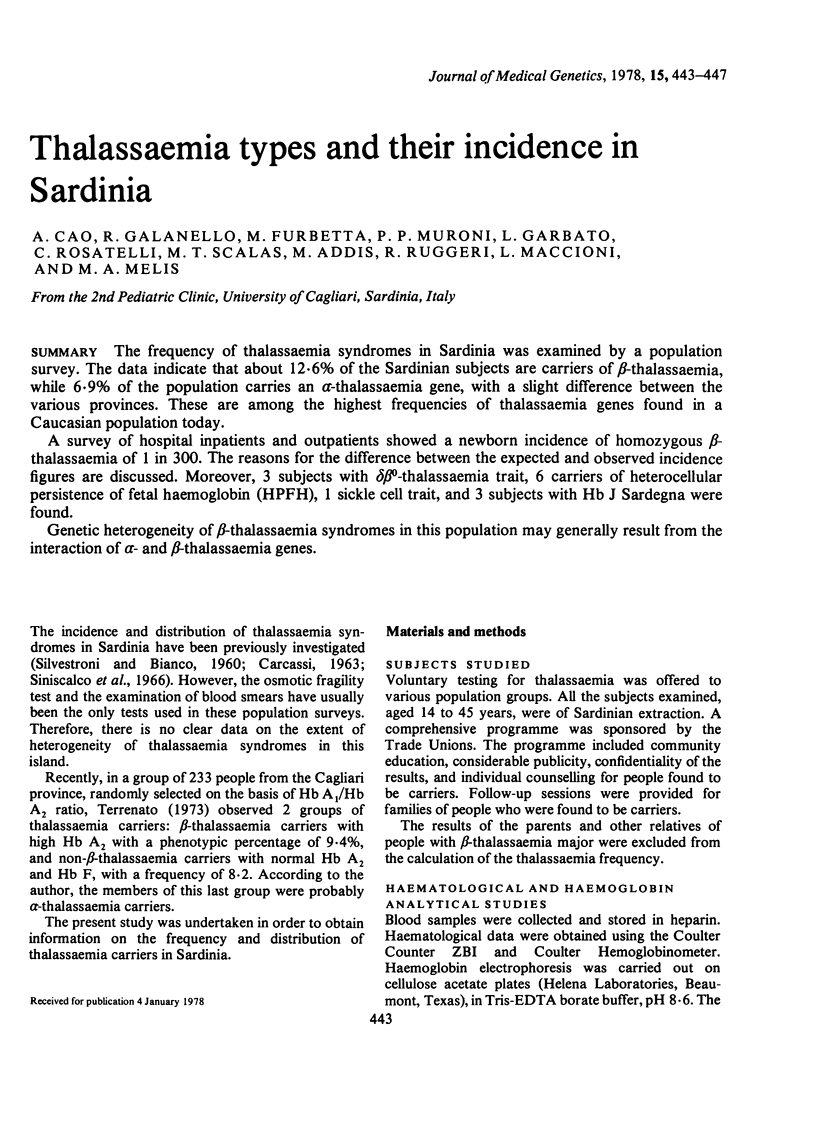
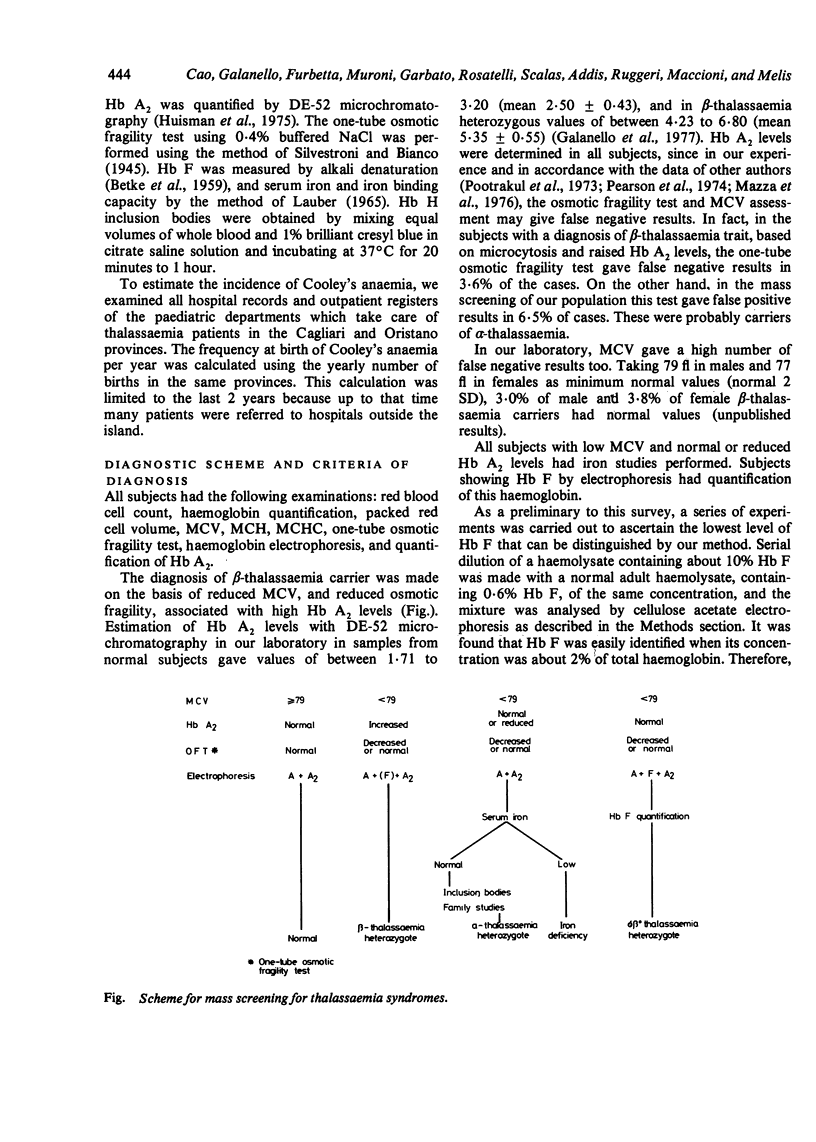
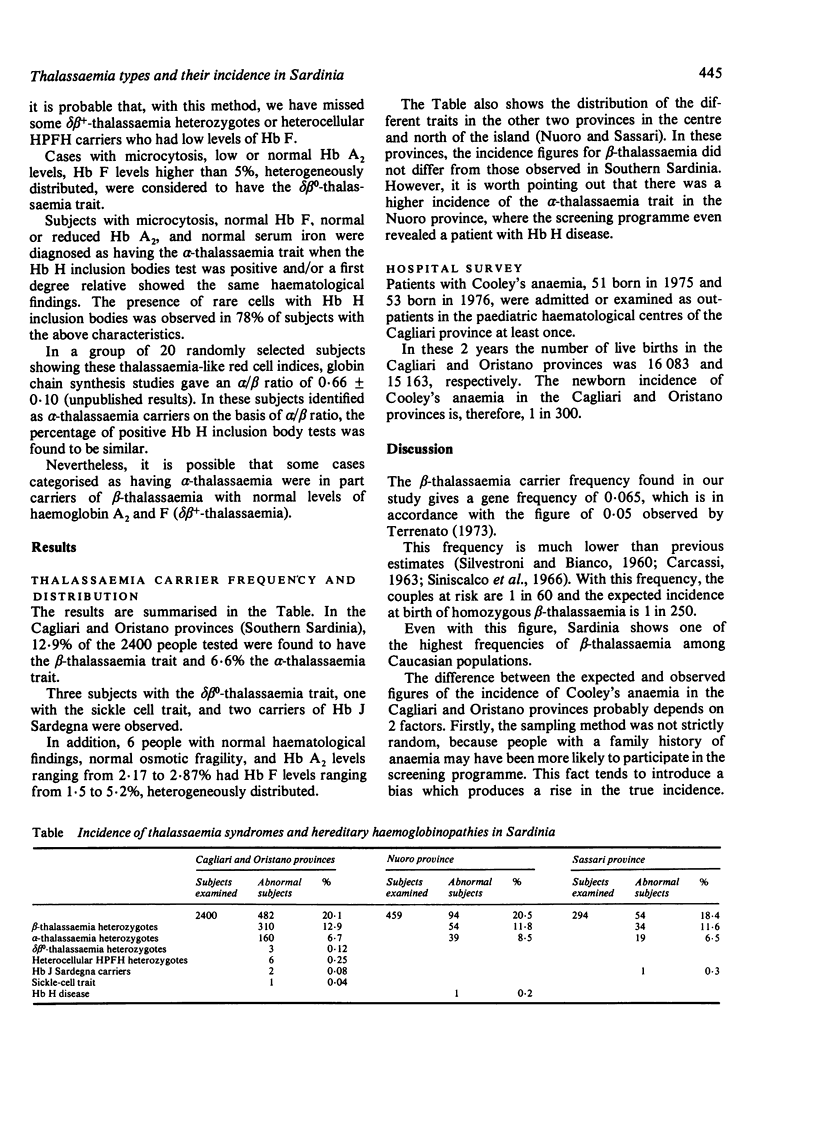
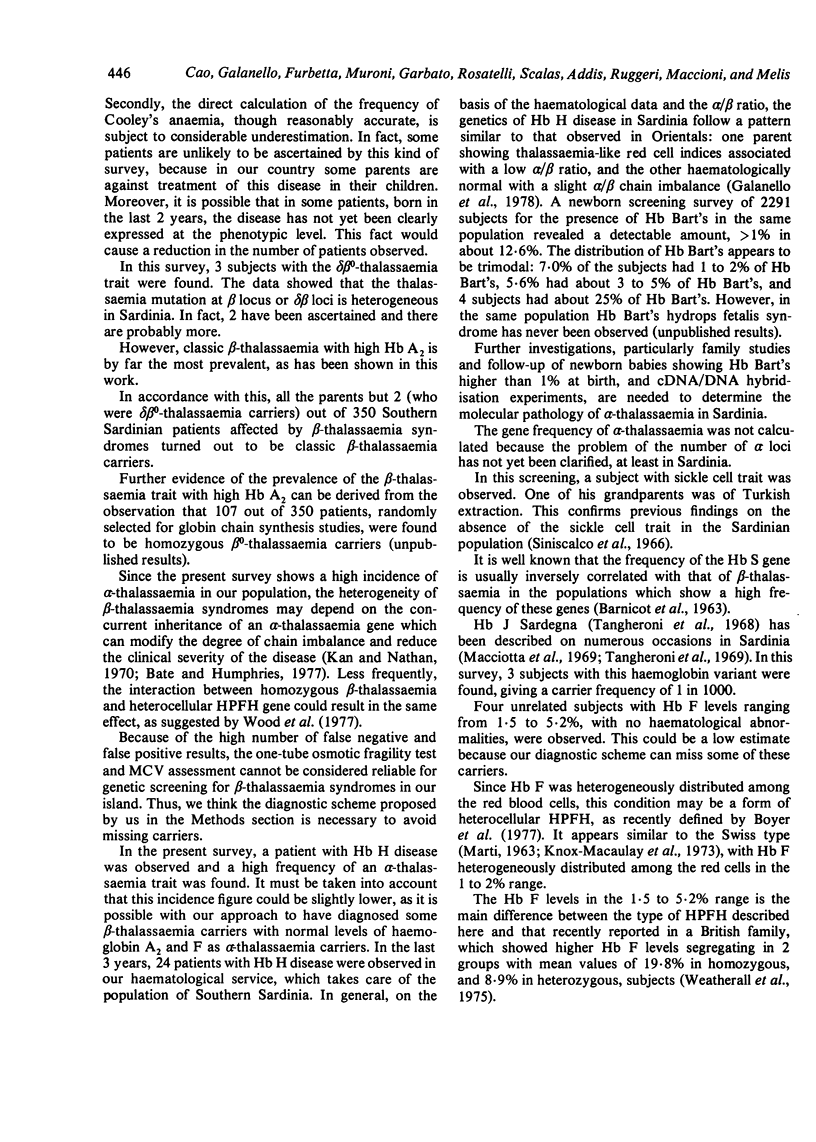
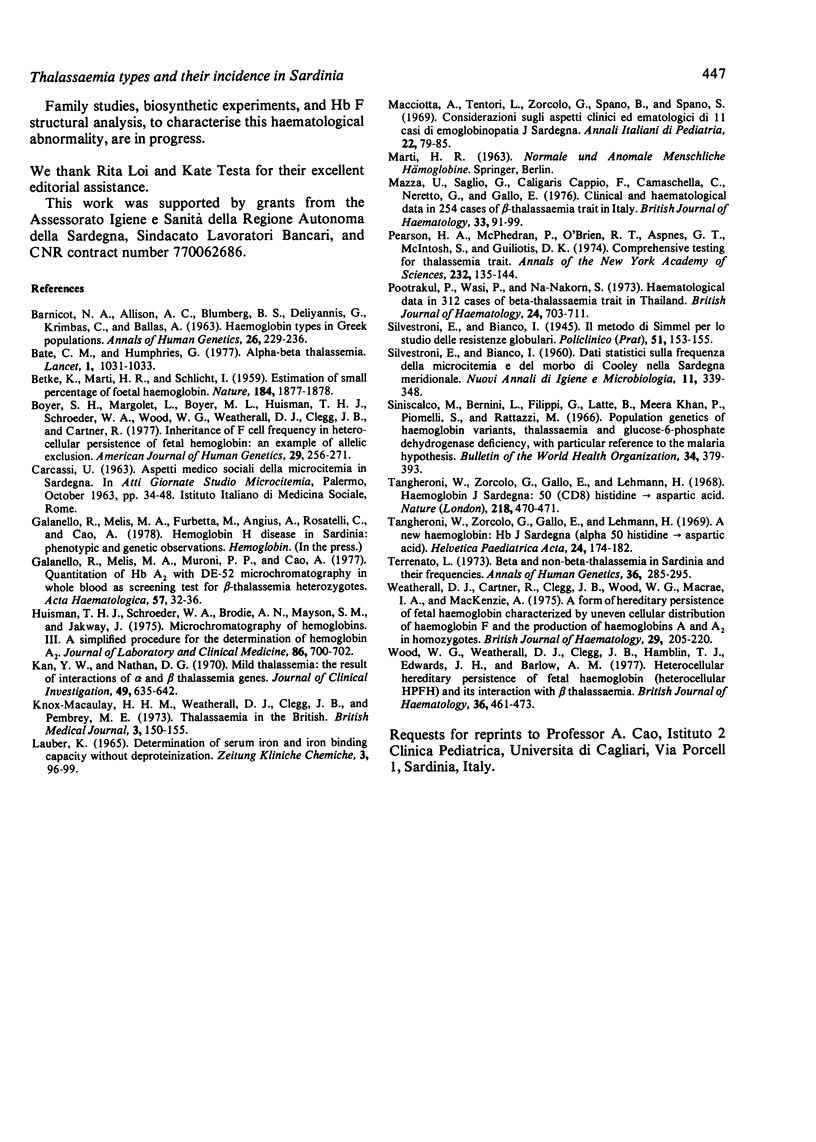
Selected References
These references are in PubMed. This may not be the complete list of references from this article.
- BARNICOT N. A., ALLISON A. C., BLUMBERG B. S., DELIYANNIS G., KRIMBAS C., BALLAS A. Haemoglobin types in Greek populations. Ann Hum Genet. 1963 Feb;26:229–236. doi: 10.1111/j.1469-1809.1963.tb01979.x. [DOI] [PubMed] [Google Scholar]
- BETKE K., MARTI H. R., SCHLICHT I. Estimation of small percentages of foetal haemoglobin. Nature. 1959 Dec 12;184(Suppl 24):1877–1878. doi: 10.1038/1841877a0. [DOI] [PubMed] [Google Scholar]
- Bate C. M., Humphries G. Alpha-beta thalassaemia. Lancet. 1977 May 14;1(8020):1031–1034. doi: 10.1016/s0140-6736(77)91261-2. [DOI] [PubMed] [Google Scholar]
- Boyer S. H., Margolet L., Boyer M. L., Huisman T. H., Schroeder W. A., Wood W. G., Weatherall D. J., Clegg J. B., Cartner R. Inheritance of F cell frequency in heterocellular hereditary persistence of fetal hemoglobin: an example of allelic exclusion. Am J Hum Genet. 1977 May;29(3):256–271. [PMC free article] [PubMed] [Google Scholar]
- Galanello R., Melis M. A., Muroni P., Cao A. Quantitation of Hb a2 with DE-52 microchromatography in whole blood as screening test for beta-thalassemia heterozygotes. Acta Haematol. 1977;57(1):32–36. doi: 10.1159/000207857. [DOI] [PubMed] [Google Scholar]
- Huisman T. H., Schroeder W. A., Brodie A. N., Mayson S. M., Jakway J. Microchromatography of hemoglobins. II. A simplified procedure for the determination of hemoglobin A2. J Lab Clin Med. 1975 Oct;86(4):700–702. [PubMed] [Google Scholar]
- Kan Y. W., Nathan D. G. Mild thalassemia: the result of interactions of alpha and beta thalassemia genes. J Clin Invest. 1970 Apr;49(4):635–642. doi: 10.1172/JCI106274. [DOI] [PMC free article] [PubMed] [Google Scholar]
- Knox-Macaulay H. H., Weatherall D. J., Clegg J. B., Pembrey M. E. Thalassaemia in the British. Br Med J. 1973 Jul 21;3(5872):150–155. doi: 10.1136/bmj.3.5872.150. [DOI] [PMC free article] [PubMed] [Google Scholar]
- Lauber K. Bestimmung von Serumeisen und Eisenbindungskapazität ohne Enteiweissung. Z Klin Chem Klin Biochem. 1965 Jun;3(3):96–99. [PubMed] [Google Scholar]
- Mazza U., Saglio G., Cappio F. C., Camaschella C., Neretto G., Gallo E. Clinical and haematological data in 254 cases of beta-thalassaemia trait in Italy. Br J Haematol. 1976 May;33(1):91–99. doi: 10.1111/j.1365-2141.1976.tb00974.x. [DOI] [PubMed] [Google Scholar]
- Pearson H. A., McPhedran P., O'Brien R. T., Aspnes G. T., McIntosh S., Guiliotis D. K. Comprehensive testing for thalassemia trait. Ann N Y Acad Sci. 1974;232(0):135–144. doi: 10.1111/j.1749-6632.1974.tb20578.x. [DOI] [PubMed] [Google Scholar]
- Pootrakul P., Wasi P., Na-Nakorn S. Haematological data in 312 cases of -thalassaemia trait in Thailand. Br J Haematol. 1973 Jun;24(6):703–712. doi: 10.1111/j.1365-2141.1973.tb01697.x. [DOI] [PubMed] [Google Scholar]
- Siniscalco M., Bernini L., Filippi G., Latte B., Meera Khan P., Piomelli S., Rattazzi M. Population genetics of haemoglobin variants, thalassaemia and glucose-6-phosphate dehydrogenase deficiency, with particular reference to the malaria hypothesis. Bull World Health Organ. 1966;34(3):379–393. [PMC free article] [PubMed] [Google Scholar]
- Tangheroni W., Zorcolo G., Gallo E., Lehmann H. A new haemoglobin: Hb J Sardegna (alpha50 histidine--aspartic acid). Helv Paediatr Acta. 1969 Apr;24(2):174–182. [PubMed] [Google Scholar]
- Tangheroni W., Zorcolo G., Gallo E., Lehmann H. Haemoglobin J Sardegna: alpha 50(CD 8) histidine -aspartic acid. Nature. 1968 May 4;218(5140):470–471. doi: 10.1038/218470a0. [DOI] [PubMed] [Google Scholar]
- Terrenato L. - And non- -thalassaemia in Sardinia and their frequencies. Ann Hum Genet. 1973 Jan;36(3):285–295. doi: 10.1111/j.1469-1809.1973.tb00591.x. [DOI] [PubMed] [Google Scholar]
- Weatherall D. J., Cartner R., Clegg J. B., Wood W. G., Macrae I. A., Mackenzie A. A form of hereditary persistence of fetal haemoglobin characterized by uneven cellular distribution of haemoglobin F and the production of haemoglobins A and A2 in homozygotes. Br J Haematol. 1975 Feb;29(2):205–220. doi: 10.1111/j.1365-2141.1975.tb01815.x. [DOI] [PubMed] [Google Scholar]
- Wood W. G., Weatherall D. J., Clegg J. B., Hamblin T. J., Edwards J. H., Barlow A. M. Heterocellular hereditary persistence of fetal haemoglobin (heterocellular HPFH) and its interaction with beta thalassaemia. Br J Haematol. 1977 Aug;36(4):461–473. doi: 10.1111/j.1365-2141.1977.tb00986.x. [DOI] [PubMed] [Google Scholar]


